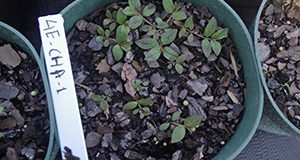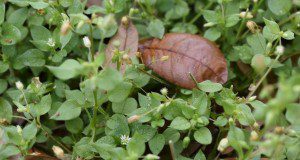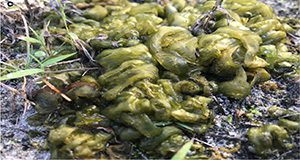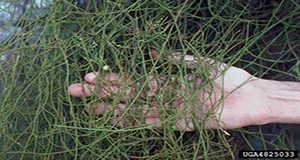Galling or witch's broom damage on the newly expanding buds and leaves of woody ornamental plants has become increasingly common. Diagnosing this damage can be difficult because the most common causes are obscure or occur well before damage symptoms appear. This 6-page fact sheet written by Adam Dale, Erin Harlow, Carrie Harmon, and Chris Marble and published by the UF/IFAS Entomology and Nematology Department is intended to help landscape managers, nursery growers, and pest control professionals diagnose characteristic galling damage, mitigate damage that occurs, and, when possible, prevent it from occurring.
https://edis.ifas.ufl.edu/in1310
Tag: Chris Marble
Biology and Management of Creeping Beggarweed (Desmodium incanum) in Warm-Season Turf
Creeping beggarweed is a common perennial broadleaf weed in Florida landscapes, home gardens, pastures, and other agricultural production systems. This new 6-page article is written for green industry professionals and others to help aid in the identification and management of creeping beggarweed in landscape turf and planting beds. Written by Grantly Ricketts and Chris Marble, and published by the UF/IFAS Environmental Horticulture Department.
https://edis.ifas.ufl.edu/ep591
Biology and Management of Florida Betony (Stachys floridana) in Ornamental Plants in Landscape Planting Beds
Florida betony (Stachys floridana) is a perennial weed in Florida landscape planting beds, gardens, turfgrass, and agricultural production systems. This new 4-page article is written for green industry professionals and others to aid in the identification and management of Florida betony in and around ornamental plants in landscape planting beds. Written by Thomas Smith and Chris Marble, and published by the UF/IFAS Environmental Horticulture Department.
https://edis.ifas.ufl.edu/ep597
Biology and Management of Galinsoga (Galinsoga quadriradiata) in Ornamental Crop Production
Galinsoga (Galinsoga quadriradiata) is an erect (upright), herbaceous, short-lived warm-season annual weed in Florida landscapes, container nurseries, and other agricultural production systems. In nurseries and landscapes, galinsoga can be a troublesome weed, but it has been utilized by some cultures for food or medicinal purposes. This new 5-page article is written for green-industry professionals and others to aid in the identification and management of galinsoga in and around ornamental plants. Written by Thomas Smith, Chris Marble, Shawn Steed, and Nathan Boyd, and published by the UF/IFAS Environmental Horticulture Department.
https://edis.ifas.ufl.edu/ep593
Distribution, Identification and Management of Two-Leaf Nightshade (Solanum diphyllum), an Invasive Plant in Florida
Two-leaf nightshade, Solanum diphyllum, is a member of the Solanaceae or potato family. It is native to Mexico southwards to Costa Rica. It has escaped cultivation in Florida and grows as far north as Duval County and from Volusia County south to Miami-Dade County. A “bird-dispersed” volunteer, it occurs in urban and conservation areas and on disturbed land. The plants produce abundant berries with many many small seeds. This new 5-page publication of the UF/IFAS Environmental Horticulture Department is primarily intended for Florida gardeners, landscapers, and land managers, and it contains information on identification, flowering, fruiting, and management recommendations for this widely occurring plant. Written by Stephen H. Brown, Chris Marble, and Stephen F. Enloe.
https://edis.ifas.ufl.edu/ep588
Biology and Management of Garden Spurge (Euphorbia hirta) in Ornamental Crop Production
Garden spurge is a prostrate, herbaceous, short-lived, warm-season annual weed commonly found in Florida landscapes, container nurseries, and other agricultural production areas. This 5-page article is written to aid green industry professionals and others in the identification and management of garden spurge in and around ornamental plants. Written by Thomas Smith, Chris Marble, Shawn Steed, and Nathan Boyd, and published by the UF/IFAS Environmental Horticulture Department, July 2020.
https://edis.ifas.ufl.edu/ep586
Biology and Management of Praxelis (Praxelis clematidea) in Ornamental Crop Production
Praxelis is a newly emerging weed species in Florida, one that Plant Protection and Quarantine (PPQ) is considering adding to the federal noxious weed list. The plant can be easily misidentified and confused with Ageratum houstonianum (bluemink) and Conoclinium coelestinum (blue mistflower) as well as several other species that have similar flower characteristics. This new 5-page article is written for green industry professionals and others to aid in the identification and management of praxelis in and around ornamental plants. Written by Yuvraj Khamare, Chris Marble, Shawn Steed, and Nathan Boyd, and published by the UF/IFAS Environmental Horticulture Department.
https://edis.ifas.ufl.edu/ep585
Use of Glyphosate and Herbicide Alternatives for Weed Control in Florida Landscape Planting Beds
This new 10-page article is written for landscape professionals and those maintaining landscape areas to guide them in selecting alternatives to glyphosate (the active ingredient in RoundUp®) for postemergence weed control in Florida. Information is also included on preemergence herbicides and integrated weed management (use of chemical and non-chemical controls), which should be the basis of a weed management program. Written by Chris Marble, Joe Neal, and Andy Senesac, and published by the UF/IFAS Environmental Horticulture Department.
https://edis.ifas.ufl.edu/ep580
Biology and Management of Common Chickweed (Stellaria media) in Ornamental Crop Production
Chickweed is a common cool-season annual weed in Florida landscapes, container nurseries, home gardens, and other agricultural production systems. This new 5-page article is written for green industry professionals and others to aid in the identification and management of chickweed in and around ornamental plants. Written by Yuvraj Khamare, Chris Marble, Nathan Boyd, and Shawn Steed and published by the UF/IFAS Environmental Horticulture Department.
https://edis.ifas.ufl.edu/ep577
Biology and Management of Doveweed (Murdannia nudiflora) in Ornamental Crop Production
Doveweed is a common warm-season annual weed in Florida landscapes, container nurseries, and other agricultural production systems. This new 5-page article is written for green industry professionals and others to aid in the identification and management of doveweed in and around ornamental plants. Preemergence and postemergence herbicides are covered, as well as basic information on doveweed biology and growth. Written by Yuvraj Khamare, Chris Marble, Nathan Boyd, and Shawn Steed, and published by the UF/IFAS Environmental Horticulture Department.
https://edis.ifas.ufl.edu/ep576
Florida Homeowner Herbicide Guide: Considerations, Applications, and Selection
While some people opt for professional lawn maintenance companies, some homeowners may wish to perform their own landscape pest control in order to save money, to have more control of what is applied, or simply because they enjoy it. This EDIS publication is for Florida gardeners, horticulturalists and homeowners who want to utilize herbicides to control weeds in their landscape. This new 9-page publication of the UF/IFAS Environmental Horticulture Department discusses common herbicides available at retail stores and how homeowners can use these them safely and effectively. Written by Chris Marble.
https://edis.ifas.ufl.edu/ep575
Biology and Management of Pusley (Richardia L.) in Tomato, Pepper, Cucurbit, and Strawberry Production
Four species of pusley (Richardia L.) are widespread and common weeds in Florida vegetable and strawberry production. We refer to the native plant Richardia scabra L. as Florida pusley. This discrimination is necessary because these species are often referred to collectively as Florida pusley due to overlapping distributions, similar growth habits and leaf morphologies, and difficulty identifying without the presence of fruit. This new 6-page publication of the UF/IFAS Horticultural Sciences Department describes the different pusley species and provides management options for strawberry, pepper, cucurbits, and tomato. Written by Shaun M. Sharpe, Nathan S. Boyd, Chris Marble, and Shawn Steed.
https://edis.ifas.ufl.edu/hs1331
Biologia y Manejo de Nostoc (Cyanobacteria) en Viveros y Invernadores
Este artículo es escrito para ayudar el lector a entender la biología y ecología de Nostoc, un género común de cianobacteria (alga verdeazulada) de suelos húmidos, y proporcionar métodos para manejar esta plaga en viveros. This 4-page document is the Spanish version of Biology and Management of Nostoc (Cyanobacteria) in Nurseries and Greenhouses. Written by H. Dail Laughinghouse IV, David E. Berthold, Chris Marble, and Debalina Saha, and published by the UF/IFAS Agronomy Department, April 2019.
http://edis.ifas.ufl.edu/ag432
Biology and Management of Spanish Needles (Bidens spp.) in Ornamental Crop Production
All eight species of Bidens in Florida are commonly referred to as Spanish needles or beggar-ticks. This document focuses on Bidens alba and B. pilosa, which are common weeds in container nurseries and landscapes in Florida. This 6-page EDIS publication, written by Yuvraj Khamare, Chris Marble, Shawn Steed, and Nathan Boyd and published by the UF/IFAS Environmental Horticulture Department, is designed for landowners, gardeners, horticulturalists, and consumers hoping to learn more about Spanish needle classification and management.
http://edis.ifas.ufl.edu/ep572
Biology and Management of Nostoc (Cyanobacteria) in Nurseries and Greenhouses
This new 4-page document provides an overview of the biology and ecology of Nostoc-like cyanobacteria (blue-green algae) in humid soils and discusses cultural, physical, and chemical methods to manage this weed in nursery environments. Written by H. Dail Laughinghouse IV, David E. Berthold, Chris Marble, and Debalina Saha, and published by the UF/IFAS Agronomy Department, February 2019.
http://edis.ifas.ufl.edu/ag430
Biology and Management of Yellow (Cyperus escuelentus) and Purple Nutsedge (C. rotundus) in Ornamental Crop Production and Landscapes
This new six-page document provides insight on characteristics and management techniques for both yellow and purple nutsedge, prevalent and persistent weeds in Florida. Written by Debalina Saha, Chris Marble, Nathan Boyd, and Shawn Steed and published by the UF/IFAS Environmental Horticulture Department, March 2019.
http://edis.ifas.ufl.edu/ep569
Key Plant, Key Pests: Pine Species (Pinus sp.)
This 6-page document is one in the Key Plant, Key Pests series. It helps identify the most common pests found on pine species. Written by Juanita Popenoe, Jacqueline Bourdon, Caroline R. Warwick, and Chris Marble and published by the UF/IFAS Environmental Horticulture Department, December 2018.
http://edis.ifas.ufl.edu/ep565
Key Plant, Key Pests: Crapemyrtle (Lagerstroemia)
This 4-page document is one in the Key Plant, Key Pests series. It helps identify pests found on the crapemyrtle, one of the most common landscape plants in north and central Florida. Written by Juanita Popenoe, Caroline R. Warwick, and Chris Marble and published by the UF/IFAS Environmental Horticulture Department, June 2018.
http://edis.ifas.ufl.edu/ep560
Biology and Management of Dodder (Cuscuta spp.) in Ornamental Crop Production and Landscape
Dodder are a group of over 150 species in the genus Cuscuta. This 4-page publication was developed to help commercial growers, landscape professionals, and homeowners identify and manage dodder infestations in their greenhouses, nurseries, or landscapes. Written by Kaley Mierek, Chris Marble, Nathan Boyd, and Shawn Steed and published by the UF/IFAS Environmental Horticulture Department, May 2018.
http://edis.ifas.ufl.edu/ep556
Biology and Management of Liverwort (Marchantia polymorpha) in Ornamental Crop Production
Liverwort is a common weed problem in production nurseries and greenhouses. This article has been written to help growers identify liverwort, understand its biology, and inform them of ways this weed can be managed in their operation. Written by Chris Marble, Marc S. Frank, Dail Laughinghouse, Shawn Steed, and Nathan Boyd, and published by UF’s Environmental Horticulture Department, September 2017.
http://edis.ifas.ufl.edu/ep542


















